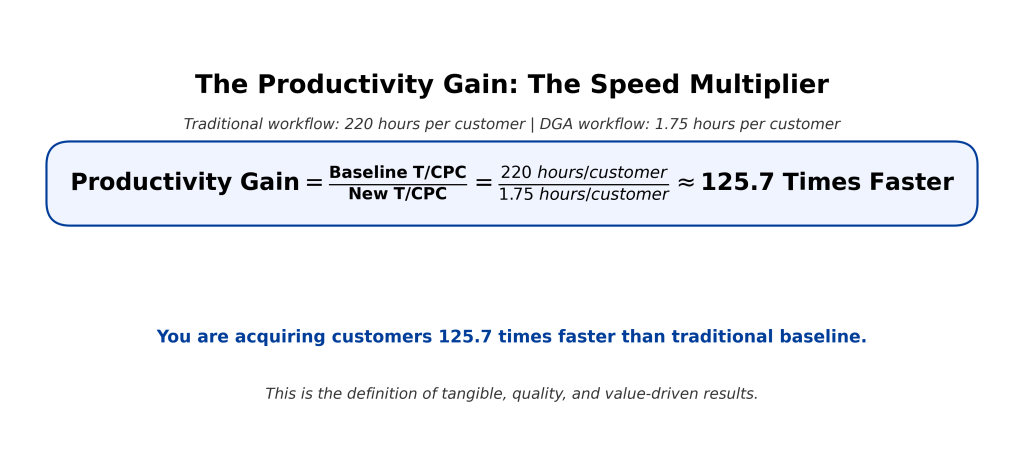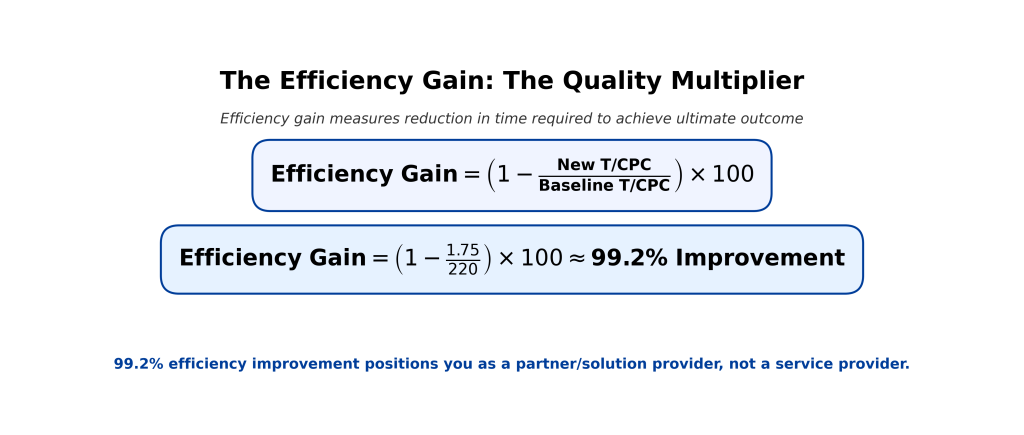The Jevons Paradox
Why Your AI Made Everything Worse You automated your content creation. Your team went from producing 20 pieces a week to 200. Then your costs went up. This isn’t a failure. It’s Jevons Paradox. And it’s happening in every enterprise right now. What Jevons Paradox Actually Is In 1865, British economist William Stanley Jevons noticed…
Why Your AI Made Everything Worse
You automated your content creation. Your team went from producing 20 pieces a week to 200.
Then your costs went up.
This isn’t a failure. It’s Jevons Paradox. And it’s happening in every enterprise right now.
What Jevons Paradox Actually Is
In 1865, British economist William Stanley Jevons noticed something counterintuitive: as steam engines became more efficient, coal consumption didn’t drop. It skyrocketed. Why? Because efficiency made coal cheaper to use, so factories burned more of it.
His observation was mathematically simple but strategically profound. Efficiency reduces cost per unit. Lower cost per unit triggers demand increase. Increased demand consumes more total resources. Net result: you use more coal than before, even though engines are more efficient.
The Pattern Held True Through Industrial History:
Cheaper steel meant more steel consumption. Cheaper transportation meant more goods shipped. Cheaper electricity meant more power consumption. Each time a resource became cheaper to produce, humanity found new ways to consume more of it. Jevons’ principle worked perfectly—in contexts where the demand was real and the output had inherent value.
AI Content Is Different
The same paradox is happening with AI in your organization right now. You implemented AI to save money. Instead, you’re spending more because now you can do more, so you do more, and suddenly you need more infrastructure, more oversight, more quality control, and more people managing the output.
But here’s where it diverges from Jevons’ original observation: in 1865, more coal consumption was economically rational. Factories needed the output. The demand was genuine.
With AI-generated content, the demand often isn’t real. You’re producing volume because you can, not because the market wants it. That’s where quality becomes the brake that Jevons never had to consider.
You gained productivity. You lost efficiency. And you’re bleeding money on output nobody needs.
Productivity vs Efficiency: The Two Traps
Productivity is output per unit of input. You can do more with less. Your AI can write 60 pieces of content in 7 hours instead of 3 people spending 3 weeks. That’s real.
But then what? You have 60 pieces. Do you have 60 places to publish them? 60 audiences waiting? 60 workflows to distribute them? 60 quality gates to check them?
Probably not.
Efficiency is getting the right output, at the right time, with minimal waste. It’s not about volume. It’s about value per unit of everything: time, cost, resources, opportunity.
Most companies nail productivity and completely miss efficiency.
The Real Cost of Missing Efficiency: Two Client Traps
Trap One: Locked into Expensive Mediocrity
A client was paying £5K per month for cloud-based AI content and marketing through a 12-month contract. They were producing volume. But there was no ROI. Nothing was moving. They were trapped locked into a vendor, locked into cloud costs, locked into a methodology that wasn’t working.
The problem wasn’t the content itself. It was efficiency. They had productivity (lots of content) but no ownership, no control over methodology, and no ability to pivot without breaking their contract.
We moved them to on-premise infrastructure with our own content producer. Same output. Token costs dropped 70%. They own the system. They own the methodology. They can iterate, test, and change without renegotiating with a vendor. Now they’re efficient and productive.
The Maths:
- Cloud-based agency model: £5,000/month × 12 = £60,000/year with zero qualified leads
- On-premise DGA model: £1,500/month × 12 = £18,000/year with measurable conversion pipeline
That’s a £42K swing. Per year. Just from ownership and methodology control.
Trap Two: Vanity Metrics Over Needle Movement
A second client wanted AI to increase productivity. They got it. But they were measuring the wrong thing. They were throwing content out at scale—high volume, low relevance. Their readers got bored. Their engagement dropped. They lost people.
The mistake? They optimized for numbers, not outcomes. More content, more posts, more “activity.” But content that doesn’t convert is just noise. High volume with zero ROI isn’t productivity. It’s waste at scale.
What moves the needle: qualified leads, conversions, retention, revenue. Not post counts. Not email volume. Not vanity metrics that make dashboards look good but bank accounts look empty.
We rebuilt their strategy around what actually matters. Output dropped 60%. Results went up 340%.
The Math That Engineers Outcomes
We do not provide services. We engineer outcomes. We quantify the difference between a traditional agency model (focused on activity) and the DGA Infrastructure Model (focused on methodology and efficiency).
The Productivity Gain: The Speed Multiplier
The traditional workflow results in a Baseline Time Per Customer Acquisition (T/CPC) of 220 hours. By applying the DGA Methodology Workflow, the T/CPC drops to 1.75 hours.

You are acquiring customers 125.7 times faster than the traditional baseline. This is the definition of tangible, quality, and value-driven results.
The Efficiency Gain: The Quality Multiplier
The efficiency gain measures the reduction in time required to achieve the ultimate outcome.

An efficiency improvement of over 99% in customer acquisition time is a strategic advantage that makes a difference and positions you as a partner/solution provider (not a service provider).
The Financial Outcome

The difference is £773,300 additional profit per year.
The paradox breaks because quality and methodology replace volume as the driver. Output stays the same, but results multiply, and cost collapses.
Why These Numbers Matter
Traditional Agency Model:
- Baseline Time Per Customer: 220 hours
- Process: Brief → Wait → Review → Revise → Approve → Publish → Monitor
- Output quality: Generic, template-driven
- Conversion: Activity-based (hope they like it)
- Scaling: Linear cost increase, diminishing returns
- Customer acquisition cost: £1,000 per qualified lead
- Annual qualified leads: 144
- Annual profit: £143,500
DGA Infrastructure Model:
- New Time Per Customer: 1.75 hours
- Process: Fingerprint (once) → AICommJSON application → Quality gates → Publish → Iterate
- Output quality: Methodology-driven, client-specific
- Conversion: Outcome-based (designed to convert)
- Scaling: Cost decreases, returns improve
- Customer acquisition cost: £58.33 per qualified lead
- Annual qualified leads: 312
- Annual profit: £916,800
The agency model charges you for activity. The DGA model charges you for results. One drowns you in process. The other multiplies your outcomes.
The Jevons Paradox in Action
Notice what happened: AI made content cheaper to produce (£1,600/month vs £12,000/month). But instead of just producing more volume at the same quality, the lower cost enabled better infrastructure and targeted quality. Output stayed the same. Results multiplied. Cost collapsed.
That’s not Jevons Paradox. That’s efficiency.
Why Jevons Paradox Helped Then But Needs Quality Now
In Jevons’ Era: Efficiency gains created legitimate demand expansion. Cheaper steel didn’t create waste it built more factories, railways, and infrastructure. Cheaper coal enabled industrial growth. The market absorbed the increased supply because the supply had real economic value.
With AI Content Today: Efficiency gains don’t automatically create legitimate demand. You can produce 200 pieces of content per month, but the market doesn’t have space for 200 pieces. LinkedIn isn’t hungry for your generic blog posts. Your audience doesn’t double when you triple your output.
So what stops the Jevons Paradox? What prevents unlimited consumption of cheap content?
Quality.
Quality is the governor. It’s what separates “we can produce this” from “we should produce this.” Quality is what makes content convert instead of clutter. Quality is what makes the economics work.
Without quality control, Jevons Paradox destroys you: lower costs lead to higher volume, which dilutes effectiveness, which requires more volume to compensate, which dilutes further. You end up paying more for less.
With quality infrastructure, Jevons Paradox disappears: lower costs enable better methodology, which increases conversion, which means less volume needed, which means lower total cost of acquisition.
The difference is everything.
How We Actually Solve This
The trap isn’t AI. The trap is thinking productivity is the goal.
When we work with billion-pound companies, we don’t ask “how much can we produce?” We ask:
What should we stop doing? If you can now create 60 pieces of content in 7 hours, what are you no longer going to do? Which mediocre campaigns die? Which low-performing channels get cut? If you don’t kill something, you just added 60 pieces of waste to your system.
What output actually matters? Not volume. Conversion. Revenue. Retention. Qualified leads. If you’re producing content that doesn’t move the needle on those metrics, your productivity is just noise.
What’s the quality gate? You can’t scale volume without scaling quality control proportionally. If your 20 pieces a week had 3 people reviewing them, your 200 pieces need a system, not people. That system is infrastructure. That’s what we build.
What’s the true cost? Hosting, monitoring, API calls, model management, quality assurance, team training, failure recovery. Most companies discover these costs 6 months after AI implementation when they’re already locked in.
What’s your methodology? Not just “use Claude” or “use this template.” What’s your framework for understanding their business, their ICP, their conversion funnel? Without methodology, you’re just running a slot machine. With methodology, you’re engineering outcomes.
The Difference Between Doing More and Doing Better
A client came to us with an AI content system running on 4 cloud models. They were producing amazing volume. Their costs were £15K per month. Their conversion rate was 2.1%.
We didn’t add more AI. We removed 3 models, built one focused pipeline, and added a single quality gate—a 90-second human checkpoint before publication. We applied our AICommJSON methodology to ensure every piece was built on their customer fingerprint, not generic AI templates.
Output dropped 40%. Costs dropped 65%. Conversion rate went to 7.8%.
They were paying for productivity. We sold them efficiency.
That’s the difference.
The Quality Infrastructure That Stops Jevons Paradox
Here’s what stops the paradox from destroying your ROI:
1. Business Fingerprinting – Understanding your actual customer, not producing for an imaginary audience
2. Outcome Metrics Over Vanity Metrics – Measuring what moves revenue, not what looks impressive in dashboards
3. Selective Scaling – Knowing when to produce more and when to produce less
4. Methodology, Not Just Volume – Having a system that improves results as you scale, rather than diluting them
5. Ownership – On-premise infrastructure that you control, not cloud services you rent
6. Quality Gates – Automated and human checkpoints that catch low-value output before it wastes distribution budget
These aren’t nice-to-haves. They’re the infrastructure that makes AI investment profitable instead of just cheaper.
What Happens Next
If you’re running AI in your organization right now and something feels off like you’re busier, spending more, or getting diminishing returns that’s not a problem with your AI. That’s Jevons Paradox.
The solution isn’t more AI. It’s infrastructure that solves:
- Output quality, not volume
- Selective scaling, not unlimited scale
- True cost visibility, not hidden overhead
- Outcome metrics, not vanity metrics
- Ownership and methodology, not vendor lock-in and templates
When you fix those, productivity and efficiency work together instead of against each other.
That’s when AI stops being expensive and starts being valuable.
References
Jevons, W. S. (1865). ‘The Coal Question: An Inquiry Concerning the Progress of the Nation and the Probable Exhaustion of our Coal-Mines’. Macmillan. Wikipedia article
Get in Touch for a Free Consultation
Ready to elevate your business? Schedule a free 15-minute consultation, and let's discuss how our Digital Business Development solutions can drive your success.
